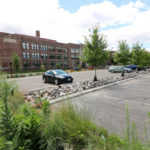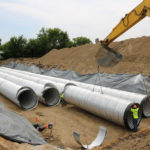In 2016, the MWMO began to monitor select, recently installed best management practices (BMPs) within the watershed. These include BMPs installed at the St. Anthony Regional Stormwater Treatment and Research System and Thomas Edison High School. MWMO’s goal in monitoring BMPs is to determine how effective they are in reducing and removing pollutants from stormwater. The results of this monitoring can help inform future, improved methods for treating and managing stormwater runoff.
St. Anthony Regional Stormwater Treatment and Research System
The St. Anthony Regional Stormwater Treatment and Research System is a large-scale BMP and research site that diverts and treats stormwater as it leaves the City of St. Anthony Village and enters the City of Minneapolis. This facility is designed to treat stormwater runoff from about 600 acres of St. Anthony Village before it continues through the stormwater drainage system and enters the Mississippi River.
Stormwater is first diverted into an underground swirl chamber that traps sediment and floating debris. Some of this treated water is then pumped through one of two filters — an iron-enhanced sand filter or a Stormfilter® cartridge chamber— while the rest flows back into the stormwater tunnel. Both filters are designed to remove phosphorus from stormwater. The water treated by the filters reenters the stormwater tunnel. The two filter chambers are designed in such a way that the current treatments may be swapped out and replaced with other innovative stormwater treatment media. In this way, the facility also acts a research resource for testing out new, emerging technologies in stormwater treatment.
The MWMO has installed monitoring equipment within the St. Anthony facility with the goal of addressing some initial research objectives:
- Evaluate the efficiency of providing stormwater treatment on a regional scale.
- Quantify the pollutant removal efficiency of each of the treatment components: swirl chamber, iron-enhanced sand filter, and Stormfilter® cartridge chamber.
- Assess differences in pollutant removal in the system between baseflow and storm events.
Edison High School Green Campus
As part of a larger Northeast Green Campus Initiative, the MWMO has collaborated with partners to construct various stormwater BMPs at Edison High School. In order to both determine the efficacy of the BMPs and to provide educational opportunities to students, monitoring equipment has been installed in them to measure water quality and water quantity entering and exiting the BMPs.
North Parking Lot Tree Trench
Three BMPs — a tree trench, pervious pavers, and a rain garden — were installed within the North Parking Lot of the Thomas Edison High School Green Campus. Runoff from an approximately 8,000 square foot area of parking lot is diverted to the tree trench. The volume of parking lot runoff entering the tree trench is measured using an area-velocity sensor. Sample bottles for water quality analysis are installed at the inlet to the tree trench and samples are analyzed for constituents such as total phosphorus, suspended sediments, total metals and other stormwater pollutants. Volume and water quality are also monitored at the outlet to the tree trench with the goal of assessing its effectiveness at infiltrating and treating stormwater.
Athletic Complex Underground Stormwater Reuse Tank
As part of a major reconstruction of the high school athletic track and field sports complex, an underground stormwater reclamation system was installed. The underground storage tank collects runoff from the gymnasium roof, athletic field, a new pedestrian plaza and a future parking lot. The water collected by the system will be used to irrigate the athletic field. Monitoring equipment to measure flow from each runoff source into the tank has been installed, and data collected by that equipment is transmitted to a public digital display on a new concession building. The amount of water reused from the storage tank is monitored to determine the amount of potable water savings provided by the reuse system.

